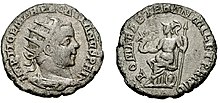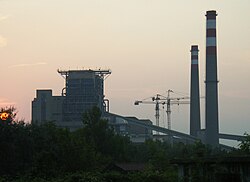Kostolac
Kostolac
Костолац | |
|---|---|
Municipality and town | |
| Country | |
| District | Braničevo |
| City | Požarevac |
| Municipality | Kostolac |
| Government | |
| • Municipality president | Vladimir Vila (SPS) |
| Population (2011)[1] | |
| • Total | 13,637 |
| Time zone | UTC+1 (CET) |
| • Summer (DST) | UTC+2 (CEST) |
| Postal code | 12208 |
| Area code | +381 12 |
| Vehicle registration | PO |
| Website | www |
Kostolac (Serbian Cyrillic: Костолац; Romanian: Caştelu) is a small Serbian town and municipality on the Danube river in the Braničevo District. The remains of the Roman capital of the province of Moesia Superior Viminacium are located near Stari Kostolac some 2 km to the east of Kostolac. Kostolac town is center of the municipality of Kostolac, which is one of the two municipalities of the City of Požarevac. Kostolac is also a center of area called Stig and home of thermo-power plants and coal mines.
History
A 1,5 million year old mammoth skeleton was uncovered in the Viminacium site in June 2009.[2]
The tribes of Autariatae and Scordisci are thought to have merged into one in this area after 313BC, since excavations show that the two groups made burials at the same exact grave field in Pecine, near Kostolac.[3] Nine graves of Autariatae dating to 4th century BC and scattered Autariatae and Celtic graves around these earlier graves show that the two groups mixed rather than made war[4] and this resulted in the lower Morava valley becoming a Celto-Thracio-Illyrian interaction zone.[5] The Celtic Invasions of Greece in 279 BC formed the sub-Celtic group of Scordisci who would according to Strabo, defeat and push the powerful Triballians towards the Getae,[6] the Scordisci self-rule in different regions of Serbia gradually ended with the Roman conquest of the Balkans in the 1st century AD.


Viminacium, a major city of the Roman province of Moesia, and the capital of Moesia Superior was situated 20 km east to the present centre, in the area of Stari Kostolac (Old Kostolac). Viminacium was the base camp of Legio VII Claudia, and hosted for some time the IV Flavia Felix. It was destroyed in 440 by the Huns, but rebuilt by Justinian I. During Maurice's Balkan campaigns, Viminacium saw destruction by the Avars in 584 and a crushing defeat of Avar forces on the northern Danube bank in 599, destroying Avar reputation for invincibility.[7]
Đorđe Vajfert opened coal mines in Kostolac. During World War II, Germans constructed first power plant "Mali Kostolac" ("small Kostolac"). After the war, people from every where came to build it.
Settlements
Aside from the town of Kostolac, the urban municipality includes the following settlements:
- Kostolac
- Klenovnik
- Ostrovo
- Petka
- Selo Kostolac
Features
- Ostrovo, the biggest island of Serbia is located near Kostolac.
Tourism
In Kostolac is the archaeological site of Viminacium, a former Roman outpost with wide streets, luxurious villas, extensive baths and an amphitheater, just recently opened to the public.
Industry

Kostolac has two thermal power plants:
- TPP "Kostolac A" – with 2 blocks – total available capacity of 281 MW and production of 716 GWh
- TPP "Kostolac B" – with 2 blocks – total available capacity of 640 MW and production of 3,027 GWh
Thermal power blocks of Economic Association "Thermal Power Plants and Mines Kostolac" plc with total available capacity of 921 MW, make 11 percent of the total available capacity of the electric power system of Serbia.
Electric power production in Economic Association "Thermal Power Plants and Mines Kostolac" plc of 3,743 GWh makes almost 11 percent of the total electric power production in EPS's (Elektroprivreda Srbije) system.
Thermal power plants Economic Association "Thermal Power Plants and Mines Kostolac" plc use fuel lignite produced at open-pit mines "Cirikovac" and "Drmno", for electric power production. These mines are visible on aerial maps available online.
In addition to electric power, TPP "Kostolac A" produces heating energy for heating the cities of Kostolac and Požarevac.
There is a plan to build a third unit of the TPP Kostolac B (TPP Kostolac B3), which will have an installed capacity of 350 MW.[8][9]
Demographics
Ethnic groups in the town (2011. census):
- Serbs = 9,842
- Roma = 2,651
- others (e.g. [Macedonians, Croats])
| Ethnicity | Number |
|---|---|
| Serbs | 9842 |
| Yugoslavs | 9 |
| Montenegrins | 22 |
| Romani | 2659 |
| Croats | 35 |
| Macedonians | 45 |
| Muslims | 8 |
| Slovaks | 3 |
| Slovenes | 19 |
| Magyars | 21 |
| Albanians | 1 |
| Romanians | 14 |
| Bulgarians | 3 |
| Russians | 2 |
| Bunjevci | 1 |
| Vlachs | 16 |
| Germans | 10 |
| Rusyn | 2 |
| Others | 38 |
| Regional identity | 2 |
| Undeclared | 173 |
| Unknown | 712 |
| TOTAL | 13637 |
See also
- Municipalities of Serbia
- Cities and towns in Serbia
- Populated places of Serbia
- Viminacium
- Kostolac Airport
References
- ^ Попис становништва, домаћинстава и станова 2011. у Републици Србији or 2011 Census of Population, Households and Dwellings in the Republic of Serbia (in Serbian). Statistical Office of the Republic of Serbia. 2012. ISBN 978-86-6161-023-3.
- ^ http://www.blic.rs/culture.php?id=4672
- ^ Jovanović 1984, 1985, 1991; Theodossiev 2000: 120- 121, cat. no. 113 with full bibliography
- ^ Jovanović 1985, 1992
- ^ http://www.caorc.org/programs/mellonpubs/Theodossiev.pdf
- ^ Strabo (VII 3, 13)
- ^ http://www.viminacium.org.rs/
- ^ Potpisan ugovor o izgradnji novog bloka TE “Kostolac“ Ministarstvo rudarstva i energetike, November 20, 2013. Retrieved on 2014-30-07.
- ^ Serbia: Ambitious energy investment plan, JV and PPP with foreign partners in new TPP and HPP, the report Serbia Energy, January 1, 2014. Retrieved on 2014-30-07.



